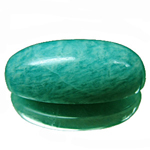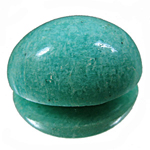Amazonite
According to the classical definition amazonite is a bluish green to green variety of microcline feldspar.
Because there are orthoclase, plagioclase and albite feldspars of similar colour the current discussion is about whether the term amazonite should be used for all feldspars of similar colour, or whether the appropriate feldspar name should be added e.g. microcline-amazonite, orthoclase-amazonite etc.
Another suggestion is microcline (amazonite variety), plagioclase (amazonite variety) etc.
Origin of Name:
Microcline: from greek μικρο- (mikro), small, little and κλίνω (klinein), stooped, tilted. The triclinic crystals of microcline strongly resemble monoclinic orthoclase crystals. The name derives from the fact that the third axis of microcline crystals is small and slightly tilted (compared to orthoclase)
Amazonite: Early mineralogist presumed one source to be near the Amazon river. Actually this source never existed.
Alexander von Humboldt (1769-1859) reported about a tribe inhabiting the Rio Negro banks who wore amazonite amulets supposedly deriving from a land were women (amazones) lived without men. (Source: Wikipedia)
Synonyms and trade names: amazon stone, amazon jade
Can be confused with: other feldspars and with jade minerals and their imitations and substitutes e.g. verdite
Localities: Very common all over the world. Commercially significant sources are South Africa, Namibia, Ethiopia, Madagascar, Brazil, Burma (Myanmar), USA and Canada.
In Austria two localities are known: Gradischkogel (a mountain in Carinthia) and the Pack (a mountain in Styria).


Amazonite from Russia, exact location unknown
Handling: Due to the perfect cleavage amazonite has to be set with extreme care. Sensitive to acid and brine.
 Deutsch
Deutsch